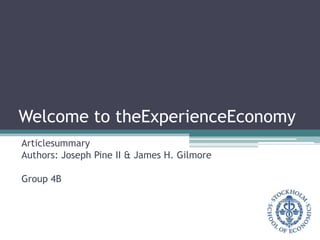
Sse experienceeconomy 4_b_2011
- 1. Welcome to theExperienceEconomy Articlesummary Authors: Joseph Pine II & James H. Gilmore Group 4B
- 2. Summary –TheArticlein Short Pine & Gilmore introduce the concept of the experience economy. The emergence of this concept represents an evolution from selling goods, to delivering services and more recently to staging experiences. An experience can be compared to a theatre play with services as the stage and goods as props. Playing the drama and engaging individual customers can then create a memorable experience. Experiences can be classified along two dimensions: The degree of participation and degree of connection. To design memorable experiences companies need a 5-step plan: theme the experience, harmonize impressions with positive cues, eliminate negative cues, sell memorabilia and engage all five senses.
- 3. History of Economic Progress The history of economic progress can be recapitulated in the 4 stage evolution of the birthday cake Mom is baking it from scratch (mix eggs, flour etc.) Mom buys pre-mixed ingredients Mom lets the bakery bake the cake Mom buys the complete birthday party (experience) where the cake is included
- 4. The ProgressionofEconomic Value The cake illustrates what happens to our economy today, the progression of economic value. Stage experiences Deliver services Differentiation Make goods Extract commodities Pricing
- 5. Whatis an „Experience“? Definition: An experience occurs when a company intentionally uses services as the stage and goods as props to engage individual customers in a way that creates a memorable event. Experiences are memorable whereas commodities are fungible, goods are tangible, services are intangible. Experiences are inherently personal, existing only in the mind of an individual. Thus no two people can have the same experience, because each experience derives from the interaction between the staged event and the individual’s state of mind.
- 6. Pricing – don‘tgiveawayexperiencesforfree! The experience economy is still immature as most companies are charging for their goods and services and not the experiences they offer Example: Hard Rock Café doesn’t charge for the events they stage But companies should consider to charge for the experiences they provide. No company sells experiences as its economic offering unless it actually charges consumer and admission fee. Example: Shopping malls that charge an admission fee before they let the customer in Charging admissions - requiring customers to pay for the experience – does not mean that companies have to stop selling goods and services Example: Walt Disney is pioneer in the experience economy and sells merchandising articles Companies need to create an experience that consumers judge to be worth the price Considerthe 4 realms of an experience
- 7. The 4 Realms of an Experience Eperiences can be characterized according to 2 dimension – connection and participation. The richest experiences, such as going to Disney World, encompass aspects of all four realms, forming a “sweet spot”. Absorption Entertainment (e.g. WebTV) Educational (e.g. Languagelab) Sweetspot Passive Participation Active Participation Esthetic (e.g. Art galleries in second life) Escapist (e.g. Playing mafia wars) Immersion
- 8. 5 Key Principles to Design Memorable Experiences Theme the experience. Use a concise and compelling theme, that drives all design elements so customers know what to expect and can organize the impression more easily. Harmonize impressions with positive cues. Impressions are the “takeaways” of an experience. To create the desired impressions, companies must introduce cues that affirm the nature of the experience to the customer. Each cue must support the theme, and none should be inconsistent with it. Eliminate negative cues. Experience stagers must eliminate anything that diminishes, contradicts or distracts from the theme.
- 9. 5 Key Principles to Design Memorable Experiences Mix in memorabilia. Complement your offer with goods that the consumer can use to remember the experience, consumer’s will even be willing to spend more on it! (e.g. Tshirt of Rolling Stones concert) Engage all five senses. The more senses an experience engages, the more effective and memorable it can be. These 5 principles are no guarantee of success! Companies have to provide consistently engaging experiences, priced relative to the value perceived from consumers and refresh the experience for their customers regularly!
- 10. 5 Key Principles – Examples from World of Warcraft Consistent theme: The most colorful fantasy world Positive cues: Rewards are given to the player depending on the time spent in the game Eliminate negative cues: World of Warcraft implemented a cue-system to facilitate creating a balanced group, which resulted in time-savings for the player Mix in memorabilia: World of Warcraft offers in-game and real-world products like mugs, clothes, toys (your own character) and in-game pets Engage all five senses: All senses except touching and smelling are engaged